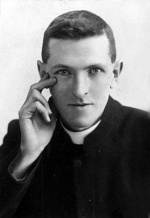Uganda parish is 100, but hits cash shortage

Pioneer priest Fr John Dunne
Thousands of people are expected to gather under mango trees in rural Uganda on September 13 - surrounded by their half-built new church. A cash shortage is holding up the completion of the new St Patrick's Church at Madera, but up to 10,000 parishioners are to mark their centenary of faith.
Catholicism was planted there in 1914 by a young British priest - along with a clump of mango trees.
"We have no seats, no windowpanes, the flooring is not done and plastering is ongoing," said parish priest Father Simon-Peter Wankya. "Due to limited finances we may be unable to have the new church ready."
It all started with Father John Dunne, a 29-year-old Mill Hill priest from Consett, County Durham, braved the swampy area to bring the Faith to poor peasant-farmers.
His part in planting mango trees have played a vital part in the growth of Catholicism.
Current parish priest Ugandan-born Fr Simon-Peter, with whom I've been in contact by email for 10 years, said: "We thank those priests, who served here from 1914-79, for bringing the faith to this area - and giving us fruits every season.
"The mangoes fed the people when food was scarce like the Israelites ate manna in the desert. The trees have also provided us with shade to pray under in recent years when the church which we are building round the old one didn't have a roof."
A report on the parish appeared in the spring issue of "Mission Today," the free quarterly magazine run by Missio and the Mill Hill Mission (best known for its red collection boxes).
Fr Simon-Peter, 49, who was educated at a Mill Hill seminary in Uganda in the 1990s, said parishioners started building in 2008 when the old church was falling to pieces, through age and bullets fired by Joseph Kony's Lord's Day Liberation Army.
The parish was originally aiming to reopen the £300,000 church on March 17, to mark the feast of St Patrick and the centenary. It is being built round the original building. The date was put back until September 13, the anniversary of the first of an amazing 110,000 children to be baptised there and in outstations.
The area was noted for being the home of "millions of mosquitoes." Mill Hill priests - many from Holland - introduced peasants to ploughing the land and attaching yokes to cattle.
Living in a "the most primitive wattle and daub construction," Fr Dunne built a grass-thatched church with mud walls. The clay floor was treated with cow dung each week to keep out ants. Later he was joined by a Dutch priest Fr Hugo Verkaaik, who focused on school building, which helped the parish's growth.
Fr Simon-Peter said: "The parish has very fond memories of early missionaries. Elderly people still recall how they became part of us and even mastered our languages.
Nearly 80 per cent of our people know how to read and write and can speak or understand English, our official language.
"Missionaries arrived to set up three institutions - the Church, school and dispensary.
Schools included girls' and boys' boarding primary schools, a technical college, a school for the blind and a teacher training college, the pride of Soroti diocese."
In 1927 a more substantial church was built to hold 600 people. But soon numbers attending Masses outgrew the building despite 50 outstations (each with its own catechist) springing up. Since the first child was baptised in 1914 some 110,000 children have been christened in the parish and parishoners now total 20,000.
Overseas missionaries stayed until 1979 when President Idi Amin's brutal regime was ousted. Then African clergy took over.
Why did - and do - so many Africans embrace Catholicism? Fr Simon-Peter said European priests - from the UK, Ireland and the Netherlands - brought civilization, medicines and schools.
"And the God of the missionaries was less demanding than their own gods, who required sacrifices. But it has taken a long time to stamp out the traditional gods. Witchcraft is still alive."
The total cost of the new church is just over £300,000, with a fifth being raised locally. The dream all started when Dutch Catholic Joseph Groberuschkamp, of St Jacobus parish in The Hague, visited St Patrick's in 2006 and left a token gift. His parish decided to hold a Lenten campaign the following year.
Then his parish priest Father Hofstede retired and generously gave his retirement gift to St Patrick's.
Some 25,000 Euros was sent by Joseph. "I left it completely up to the St Patrick's parish how to spend the money. They decided to build a completely new structure. Courageous. It took a year to find how to send the money in an open secure way involving the diocese of Soroti. They started with the project in 2008."
Last year an American in the archdiocese of Cincinnati Michael Vanderburgh, of Dayton, Ohio, paid for Father Simon-Peter to travel there and appeal for funds. So US dollars were added to the mix of British pounds sterling, Euros and Ugandan shillings.
Father Simon-Peter's dream, now coming true, is a far cry from worshipping under the mango trees planted 100 years ago.
If any reader would like to make a financial donation to St Patrick's, ICN correspondent retired Catholic journalist Michael Morrissey, of Saltburn-by-Sea, North Yorkshire, UK, asks that they telephone him on 01287-622492. He has a secure electronic route to the Madera parish.















